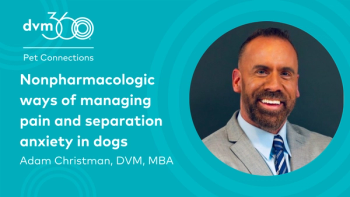
Exams too often botched up
Examination is 50 percent of the work of our profession. Examination is the key to our success or failure in the pursuit of our profession. Examination is the most botched up service performed by fully 50 percent of our colleagues in both its qualitative and quantitative aspects.
Examination is 50 percent of the work of our profession. Examination is the key to our success or failure in the pursuit of our profession. Examination is the most botched up service performed by fully 50 percent of our colleagues in both its qualitative and quantitative aspects.
Gerald Snyder
Most of the practices I visit do not perform complete physicals on their patients. Yes it's true!
The ophthalmoscope seldom comes out of its charger. The gloved finger seldom reaches the nether regions. The tonometer is caked with dust from disuse. The stethoscope seldom makes it to more than one side of the chest, and the detection of a beating heart and no cough must mean that the lung fields need no further listening to. Lymph nodes are suffering from the neglect of non-palpation. It's enough to make a grown dog or aging clinical professor cry!
And the reason for this is just plain dumb! Expediency is the watchword of the day! Move 'em in move 'em out. Next patient please! Let's see 20 to 30 patients per veterinarian today. It does not matter that each patient had 2.4 clinical entities and we only found two. If it gets bad enough, they'll be back. It could be too late to treat, but they'll be back!
Money is truly the root of all evil. Terrorism is funded by oil riches. Cotton and sugar wealth funded slavery and short- cut examinations are just another extension of the syndrome in human and veterinary medicine. The complete examinations of the new graduate are, sadly, history after three to five years of practice. Just like grandma's recipes for the exotic dishes of the "old country," they soon will become lost skills, and wealthy veterinarians will never become a world problem.
The ironic part of this ongoing tragedy is that the 10 to 15 percent longer examination time needed to do the job fully and correctly produces 30 to 40 percent more dollars in income. My consulting practices have learned that there is no economic substitute for thoroughness. Even the bill that the client gets to pay shortcuts the message with a too-simple office visit or examination.
There are three types of examinations in most practices today. They are: Examination (Wellness), Examination (Diagnostic) and Examination (Progress).
They should look like this on the bill:
Examination (Diagnostic) $XX.YY
Review of patient medical history. Evaluation of the health status of your pet's coat and skin, eyes and ears, nose and throat, mouth, teeth and gums, dental scoring, heart and lungs, abdomen and chest, musculoskeletal system and lymph nodes, urogenital and reproductive systems, neurological system, body score and nutrition.
Review of medical findings. Formulate treatment plans as required. Include hazardous waste disposal.
How can you justify doing all of the above? It's easy. Just charge for it. How much can you charge, you ask? That's easy. For small animal practice on non-exotics the fee should be 0.00056-0.00061 times the average family income in the five-mile radius around your practice. (Not the zip code, the five mile radius.) If the average family income is $60,000, in the 2003 Census update, then the Examination (Diagnostic) fee (dog and cat practice) will be well accepted at $33.60 to $36.60. For a feline specialty practice in the same neighborhood, the most successful numbers are 0.00066-0.00071 or $39.60 to $42.60. Lest you think that I am campaigning for a new 60-cent coin, if the average family income is $68,466, then the dog and cat numbers are $38.35 to $41.80 and the cat-only practice fee becomes $45.20 to $48.60.
I must admit that I only know that these are the best and most successful numbers because we have done them for just more than 2,700 practices in the U.S. and Canada to date.
Examination (Wellness) is charged at exactly the same fee with a reasonable fee for vaccinations added. Examination (Progress) is charged successfully at 80 percent of these fees.
A neighborhood family average income of $48,466 calls for a dog and cat exam fee of between $27.15 and $29.55. When the veterinarian decides, through ego or whimsy, that she or he is worth more than that and charges $35, her or his practice suffers a loss of new clients. The rest of the fees were set as scientifically as her/his office fee but had not been raised for years as 90 percent of the adjustments to gain more income were made to the examination fees. A new restaurant soon finds out what the locals will pay for chicken dumpling soup by fiddling with the price to see where there are diminishing returns. Veterinarians seldom follow that path. They reach into the dark recesses of their nethermind and pull out a fee. Good or bad, successful or less so, that's the fee. They have no way to measure their success. But surprise, surprise! There is a way. Did you ever doubt that mathematics can solve all of the problems of the world?
Your hospital average transaction fee (ATF) is derived from dividing your total gross revenue by the number of invoices needed to produce those revenues.
In the example of the dog and cat practice with a $48,466 local family income, the practice owner set its Examination (Diagnostic) fee at $35 and had a year- end ATF of $67.45. The rule is that ATF must equal 3.0-3.3 time the Examination (Diagnostic), so they should have an ATF of $27.15 to $29.55 x 3 to 3.3 or $81.45 to $97.51. It's just that simple!
This three doctor practice saw 13,000 transactions x $67.45 for a gross of $876,850.
Had they set their fees properly based on a lower Examination (Diagnostic) fee ($27.15) and a fee schedule proportionate to that family income level, the ATF should have been at least $81.45, and the same 13,000 transactions would have produced $1,058,850. A gain of $182,000.
As the additional $182,000 is pure and free from rent, labor, utilities and other overhead, it is likely to be 80 percent profit generating $145,600 to the bottom line and an additional take home (before taxes) of $48,533 for each of the three practitioners and a generous helping to the IRS to aid our country in the battle against terrorism.
Know your neighborhood demographics. Your retirement and your country depend on it!
Newsletter
From exam room tips to practice management insights, get trusted veterinary news delivered straight to your inbox—subscribe to dvm360.




